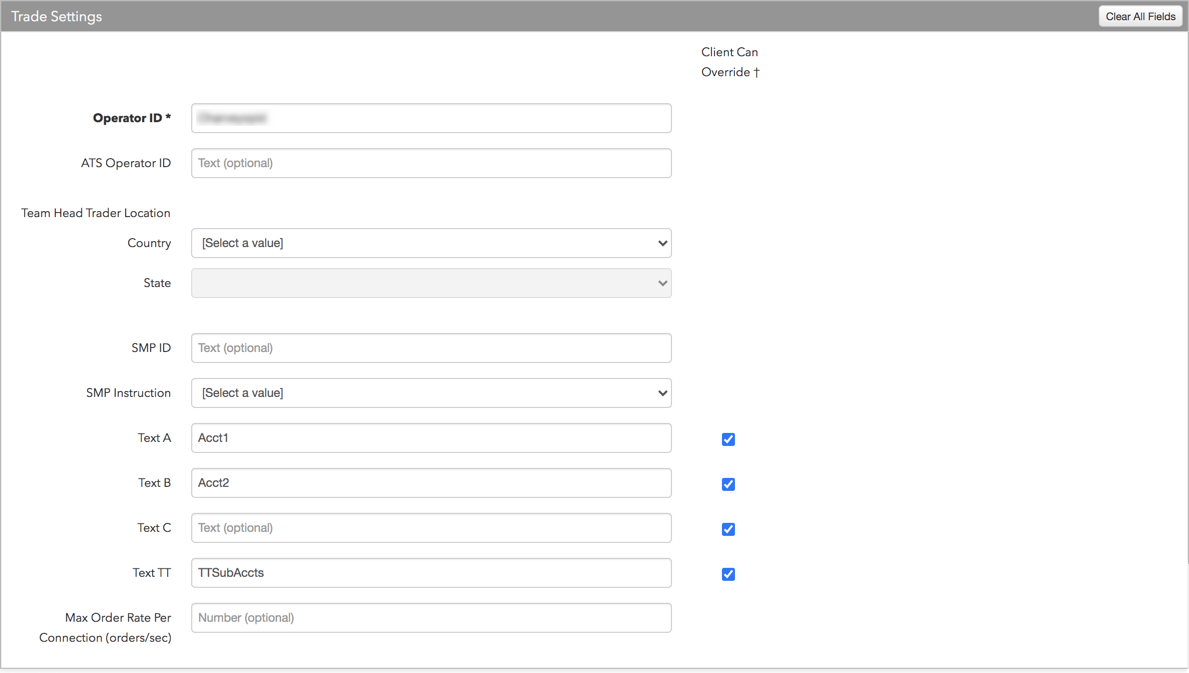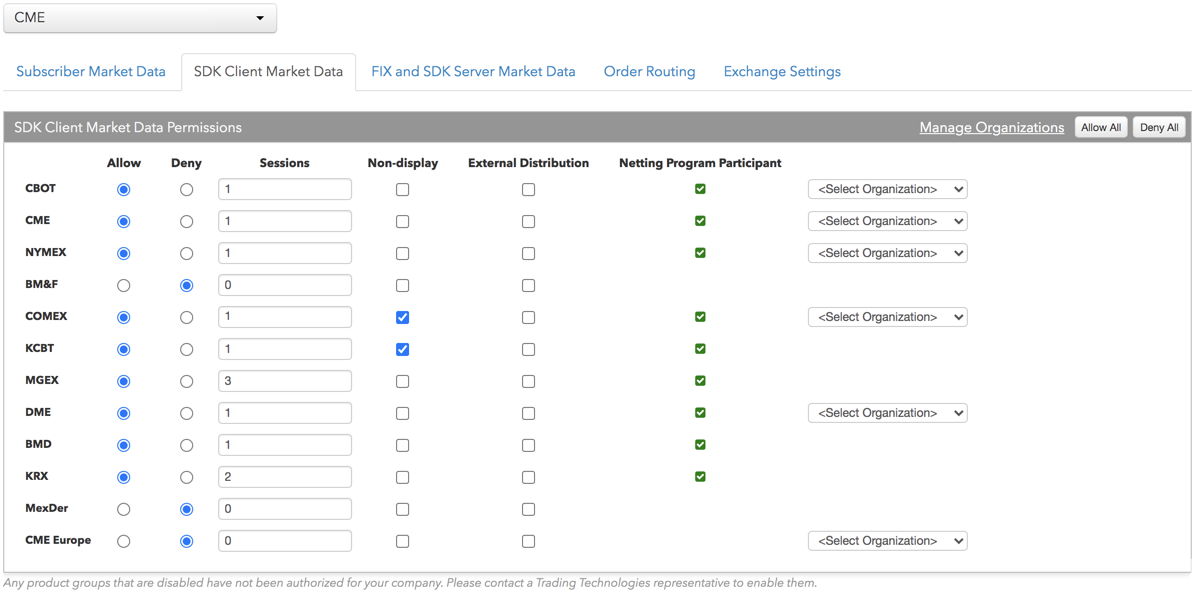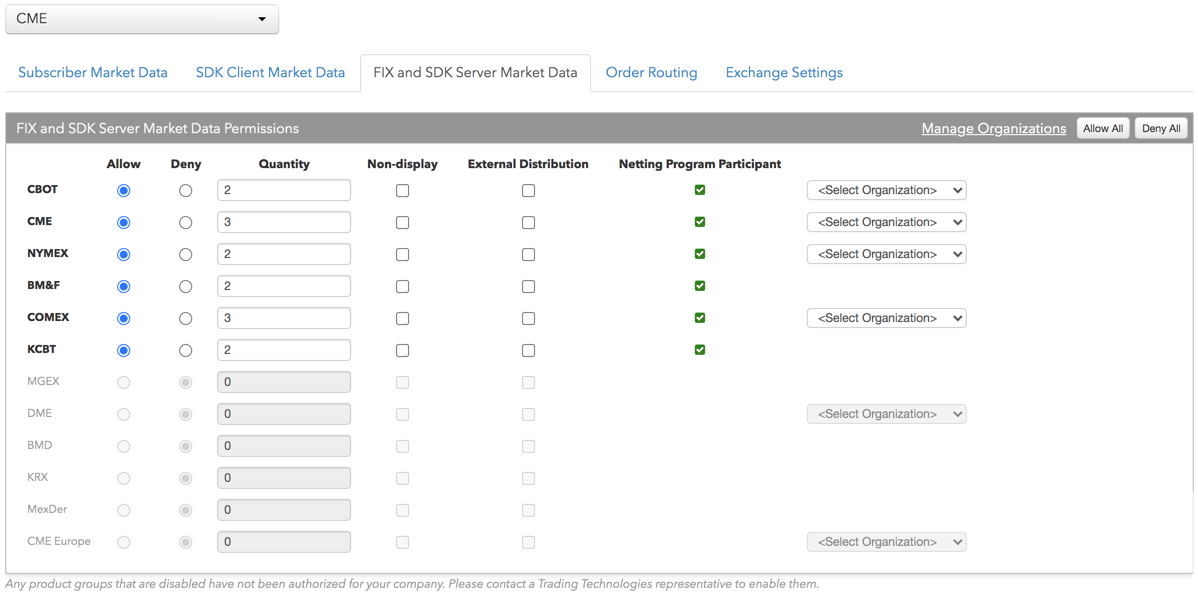CME
Configuring user access to CME
Note: Users can be assigned to accounts with CME iLink 3 MSGW connections in UAT.
Order routing and market data access are configured on the Users | Exchange Properties | Order Routing and Market Data tabs. Additional settings for reporting market data access are also provided. When you click the Exchange Properties tab, Setup defaults to the Order Routing tab.
In Setup, each CME Netting Program Participant for market data access is identified as an 'organization'. You can set a user's Netting Program Participant per market data group by selecting an existing participant or creating a new one. They can also use the Manage Organizations tab to manage a list of CME Netting Program participants.
A user that participates in the CME’s netting program is billed directly by CME. Trading Technologies still reports this user's market data access to the exchange, but reports them as non-billable. By default, no organization is selected.
For a list of exchanges and supported products when allowing or denying Market Data access for a user, refer to the CME Group website.
To configure user access to CME:
- Click the Users | Exchanges tab for a user selected in the data grid.
- Click the exchange list drop down arrow, and scroll to and select an exchange.
- Click the Subscriber Market Data, SDK Client Market Data, FIX and SDK Market Data and Order Routing tabs to configure the user for the selected exchange:
- Use the Subscriber Market Data tab to allow or deny user access to all subscriber market data or market data per product group.
- Use the SDK Client Market Data tab to allow or deny user access to market data using TT .NET SDK Client Side trading applications.
- Use the FIX and SDK Market Data tab to allow or deny user access to market data using FIX, TT .NET SDK Server Side, and TT Core SDK trading applications.
- Use the Order Routing tab to configure exchange credentials for user identification.
- Configure the following CME exchange settings for Order Routing per user:

- Operator ID — Identifies the user in Tag 50 on all manual or automated trading actions sent to the exchange by an individual. Users must register the Operator ID with the exchange. This is a required field.
Note: When this user is assigned to an account with an iLink 3 Market Segment Gateway (MSGW) connection in Setup, this value is sent to the exchange as Tag 5392, Sender ID.
- ATS Operator ID — Identifies the user in Tag 50 who is part of a registered ATS Team, where the team members are simultaneously monitoring an Automated Trading System. Manual order actions should not be submitted using the ATS Operator ID. Users must register the ATS Operator ID with the exchange.
Note: When this user is assigned to an account with an iLink 3 Market Segment Gateway (MSGW) connection in Setup, this value is sent to the exchange as Tag 5392, Sender ID.
- Team Head Trader Location — Sets the location of the Team Head Trader for anyone who is a registered Team Member using an ATS Operator ID. If set, the Team Head Trader location overrides the value in Tag 142, the sender location of the user set by the country and state/province fields on the Users | Profile tab. An ATS Operator ID is used only for teams who are simultaneously monitoring an automated trading system. All team members' order actions are sent to CME with the location of the Team Head Trader.
- Country: Sets the country of the Team Head Trader. This field is required if an ATS Operator ID is entered.
- State: Sets the state or province of the Team Head Trader. This field may be required based on which Country is selected. This field is required if an ATS Operator ID is entered.
- SMP ID — Sets a Self-Match Prevention Identifier (SMP ID) for the account. An SMP is optional and allows an executing firm to prevent the matching of orders for accounts with common ownership if both the buy and sell orders contain the same SMP ID and Executing Firm ID. Sent to the exchange as Tag 7928.
- SMP Instruction — Sets which order is canceled (resting or aggressing) if self-match prevention occurs. This setting is optional. If no SMP Instruction is specified, the resting order is canceled. If set, the value is sent to the exchange in Tag 8000. To assign a self-match prevention instruction to an order action, select one of the following:
- Cancel resting — Cancels the resting order and sends the aggressing matching order to the exchange.
- Cancel aggressing — Leaves the resting order in the market and cancels the aggressing matching order.
- Text A — An optional, user-defined text value that remains on submitted orders in the TT system, but is not sent to the exchange. Alpha-numeric and special characters are allowed.
Note: When this user is assigned to an account with an iLink 3 Market Segment Gateway (MSGW) connection in Setup, this value is sent to the exchange as Tag 5149, Memo.
- Text B — An optional, user-defined text value that remains on submitted orders in the TT system, but is not sent to the exchange. Alpha-numeric and special characters are allowed.
- Text C — An optional, user-defined text value that remains on submitted orders in the TT system, but is not sent to the exchange. Alpha-numeric and special characters are allowed.
- Text TT — An optional, user-defined text value that remains on submitted orders in the TT system, but is not sent to the exchange. Alpha-numeric and special characters are allowed.
- Max Order Rate — Sets the maximum number of orders per second that a user can enter per connection. This limit cannot exceed the exchange-defined order rate maximum.
- Client Can Override — Determines if a user can override the value in this field when submitting orders from trading applications or APIs. Check the check box to unlock the field and allow a user to override the value. When unchecked, the field is locked and the user cannot change it.
- Operator ID — Identifies the user in Tag 50 on all manual or automated trading actions sent to the exchange by an individual. Users must register the Operator ID with the exchange. This is a required field.
-
Click the Subscriber Market Data tab to allow or deny access to the following market data groups available at the
exchange:
If Allow is enabled, click Sessions to set how many simultaneous market data sessions the user can have active using different IP Addresses/Applications. Selecting 0 - Delay Only indicates that the product group is denied in all environments except the delayed environment, which does not have access to real-time market data.
Note: Any product groups that are disabled have not been authorized for your company. Please contact a Trading Technologies representative to enable them.
For exchanges that require market data agreements, the following indicators are displayed next to the "Sessions" field:
 — Indicates the market data agreement has been approved.
— Indicates the market data agreement has been approved.
 — Indicates the market data agreement is outstanding or pending approval.
— Indicates the market data agreement is outstanding or pending approval.
Tip: Click a market data indicator to open the Agreements tab.
For each group with Allow enabled:- For Netting Program Participant, set whether the user participates in the CME’s netting program for the product group. Click the selector and select the name of the user’s CME Netting Program participant organization. This is typically the user's company name, but could be a specific group within a company that has an agreement with CME.
- Manage Organizations — Click Manage Organizations to open the Organizations tab and add Netting Program Participant organizations to your company. You can also edit organizations or view which product groups are approved for the exchange netting program.
-
Click the SDK Client Market Data tab to allow or deny access to the market data groups available at the
exchange for TT .NET SDK Client Side trading applications.
If you click Allow to enable a market data group, configure the Sessions field as follows:
- If using only TT .NET SDK Client Side application keys, then set Sessions equal to the number of application keys you plan to run concurrently.
- If using only TT .NET SDK Client Side - Non-display application keys, then set Sessions equal to "0" and check the Non-display checkbox, which indicates the market data is for non-display purposes (e.g., black-box algorithm, automated program for calculating P/L, etc.) as defined by the exchange.
- If using both TT .NET SDK Client Side and TT .NET SDK Client Side - Non-display application keys, then set Sessions equal to the number of TT .NET SDK Client Side application keys that you plan to run concurrently and check the Non-display checkbox.
If you are distributing the market data externally (e.g., to users outside of your company), check the External Distribution checkbox.
Note: Any product groups that are disabled have not been authorized for your company. Please contact a Trading Technologies representative to enable them.

For each group with Allow enabled, also configure the following:- For Netting Program Participant, set whether the user participates in the CME’s netting program for the product group. Click the selector and select the name of the user’s CME Netting Program participant organization. This is typically the user's company name, but could be a specific group within a company that has an agreement with CME.
- Manage Organizations — Click Manage Organizations to open the Organizations tab and add Netting Program Participant organizations to your company. You can also edit organizations or view which product groups are approved for the exchange netting program.
-
Click the FIX and SDK Server Market Data tab to allow or deny access to the market data groups available at the
exchange for TT FIX, TT .NET SDK Server Side, and TT Core SDK trading applications.
If you click Allow to enable a market data group, click Quantity to set the number of users viewing the market data behind the FIX feed or the number of TT .NET SDK Server Side or TT Core SDK applications using the data concurrently.
If the FIX feed or SDK server-side trading application is for non-display purposes (e.g., black-box algorithm, program for calculating P/L, etc.) as defined by the exchange, click Allow to enable the market data group, set the Quantity, and check Non-display.
If you are distributing the market data externally (e.g., to users outside of your company), check the External Distribution checkbox.
Note: Any product groups that are disabled have not been authorized for your company. Please contact a Trading Technologies representative to enable them.

For each group with Allow enabled, you also configure the following:- For Netting Program Participant, set whether the user participates in the CME’s netting program for the product group. Click the selector and select the name of the user’s CME Netting Program participant organization. This is typically the user's company name, but could be a specific group within a company that has an agreement with CME.
- Manage Organizations — Click Manage Organizations to open the Organizations tab and add Netting Program Participant organizations to your company. You can also edit organizations or view which product groups are approved for the exchange netting program.
- Configure the following options on the Exchange Settings tab:

- Non-Professional — Sets whether the CME market data user is considered a "non-professional" trader for CME billing purposes. When this setting is enabled, the CME non-professional self-certification agreement is sent to the user's Agreements tab for the user to sign. The status "Pending Verification" is displayed until the agreement is signed. This checkbox is unchecked by default. Note: To maintain non-professional status, the user must remain in compliance with the CME non-professional rules as defined in the non-professional self-certification agreement. Users who are not in compliance will be billed by CME at the professional rate.
- Support Waiver — Sets whether this user has a Support Waiver granted by a specific agreement with CME. When this setting is enabled, the CME Support Waiver Request form is sent to CME for approval. The status "Pending Verification" is displayed until CME informs TT administrators that the form is approved. This checkbox is unchecked by default.
- Click Save Changes.